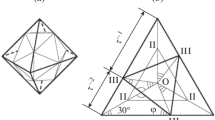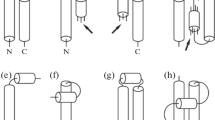Abstract:
Helices and dense packing of spherical objects are two closely related problems. For instance, the Boerdijk-Coxeter helix, which is obtained as a linear packing of regular tetrahedra, is a very efficient solution to some close-packing problems. The shapes of biological helices result from various kinds of interaction forces, including steric repulsion. Thus, the search for a maximum density can lead to structures related to the Boerdijk-Coxeter helix. Examples are presented for the -helix structure in proteins and for the structure of the protein collagen, but there are other examples of helical packings at different scales in biology. Models based on packing efficiency related to the Boerdijk-Coxeter helix, explain, mainly from topological arguments, why the number of amino acids per turn is close to 3.6 in -helices and 2.7 in collagen.
Similar content being viewed by others
Author information
Authors and Affiliations
Additional information
Received 26 November 1998 and Received in final form 12 April 1999
Rights and permissions
About this article
Cite this article
Sadoc, J., Rivier, N. Boerdijk-Coxeter helix and biological helices. Eur. Phys. J. B 12, 309–318 (1999). https://doi.org/10.1007/s100510051009
Issue Date:
DOI: https://doi.org/10.1007/s100510051009




